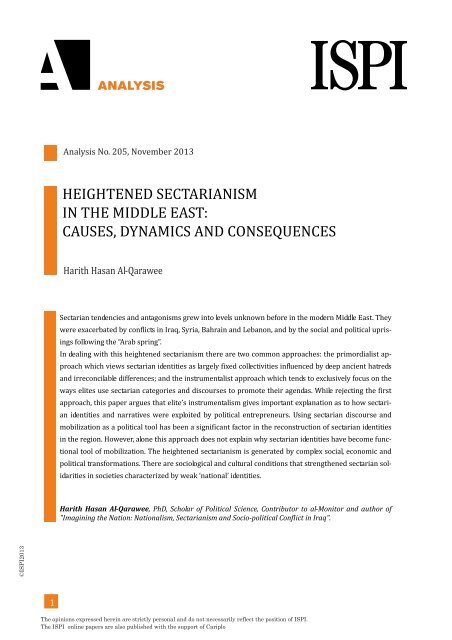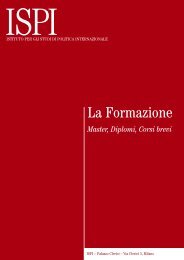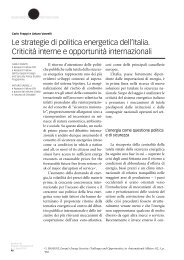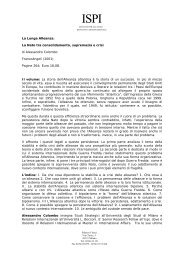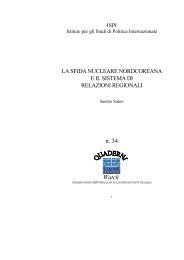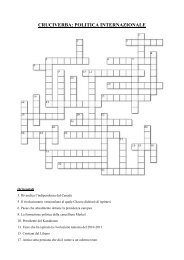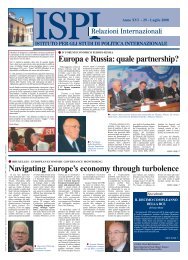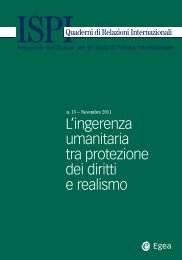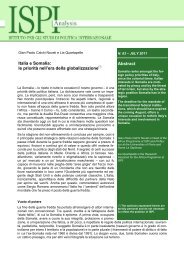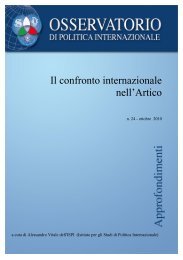heightened sectarianism in the middle east: causes, dynamics ... - Ispi
heightened sectarianism in the middle east: causes, dynamics ... - Ispi
heightened sectarianism in the middle east: causes, dynamics ... - Ispi
You also want an ePaper? Increase the reach of your titles
YUMPU automatically turns print PDFs into web optimized ePapers that Google loves.
Analysis No. 205, November 2013HEIGHTENED SECTARIANISMIN THE MIDDLE EAST:CAUSES, DYNAMICS AND CONSEQUENCESHarith Hasan Al‐QaraweeSectarian tendencies and antagonisms grew <strong>in</strong>to levels unknown before <strong>in</strong> <strong>the</strong> modern Middle East. Theywere exacerbated by conflicts <strong>in</strong> Iraq, Syria, Bahra<strong>in</strong> and Lebanon, and by <strong>the</strong> social and political upris<strong>in</strong>gsfollow<strong>in</strong>g <strong>the</strong> “Arab spr<strong>in</strong>g”.In deal<strong>in</strong>g with this <strong>heightened</strong> <strong>sectarianism</strong> <strong>the</strong>re are two common approaches: <strong>the</strong> primordialist approachwhich views sectarian identities as largely fixed collectivities <strong>in</strong>fluenced by deep ancient hatredsand irreconcilable differences; and <strong>the</strong> <strong>in</strong>strumentalist approach which tends to exclusively focus on <strong>the</strong>ways elites use sectarian categories and discourses to promote <strong>the</strong>ir agendas. While reject<strong>in</strong>g <strong>the</strong> firstapproach, this paper argues that elite’s <strong>in</strong>strumentalism gives important explanation as to how sectarianidentities and narratives were exploited by political entrepreneurs. Us<strong>in</strong>g sectarian discourse andmobilization as a political tool has been a significant factor <strong>in</strong> <strong>the</strong> reconstruction of sectarian identities<strong>in</strong> <strong>the</strong> region. However, alone this approach does not expla<strong>in</strong> why sectarian identities have become functionaltool of mobilization. The <strong>heightened</strong> <strong>sectarianism</strong> is generated by complex social, economic andpolitical transformations. There are sociological and cultural conditions that streng<strong>the</strong>ned sectarian solidarities<strong>in</strong> societies characterized by weak ‘national’ identities.Harith Hasan Al‐Qarawee, PhD, Scholar of Political Science, Contributor to al‐Monitor and author of"Imag<strong>in</strong><strong>in</strong>g <strong>the</strong> Nation: Nationalism, Sectarianism and Socio‐political Conflict <strong>in</strong> Iraq".©ISPI20131The op<strong>in</strong>ions expressed here<strong>in</strong> are strictly personal and do not necessarily reflect <strong>the</strong> position of ISPI.The ISPI onl<strong>in</strong>e papers are also published with <strong>the</strong> support of Cariplo
IntroductionSectarian tendencies and antagonisms grew <strong>in</strong>to levels previouslyunknown <strong>in</strong> <strong>the</strong> modern Middle East. They were exacerbated byconflicts <strong>in</strong> Iraq, Syria, Bahra<strong>in</strong> and Lebanon, and by <strong>the</strong> socialand political upris<strong>in</strong>gs follow<strong>in</strong>g <strong>the</strong> Arab Spr<strong>in</strong>g. Some argue that<strong>the</strong> Sunni-Shi’a divide, <strong>in</strong> particular, is “on its way to displac<strong>in</strong>g<strong>the</strong> broader conflict between Muslims and <strong>the</strong> West as <strong>the</strong> primarychallenge fac<strong>in</strong>g <strong>the</strong> Islamic societies of <strong>the</strong> Middle East for <strong>the</strong>foreseeable future” 1 .The toppl<strong>in</strong>g of Saddam’s regime and <strong>the</strong> occupation of Iraq by USforces <strong>in</strong> 2003 <strong>in</strong>tensified sectarian conflict and resulted <strong>in</strong> extremeforms of <strong>in</strong>ter-communal violence. As a consequence, a processof identity construction that emphasizes <strong>the</strong> sectarian dividewith<strong>in</strong> Islam has fur<strong>the</strong>r evolved and its geopolitical implicationsbegun to be noticeable. This process ga<strong>in</strong>ed momentum after <strong>the</strong> upris<strong>in</strong>g<strong>in</strong> Syria <strong>in</strong> 2011 that led to a bloodshed that has <strong>the</strong> characteristicsof sectarian civil war. The Syrian war became a proxy war, <strong>in</strong>volv<strong>in</strong>gstates and non-state actors divided between predom<strong>in</strong>antly Sunni andpredom<strong>in</strong>antly Shi’a camps.This paper exam<strong>in</strong>es both <strong>the</strong> socio-cultural contexts of this <strong>heightened</strong><strong>sectarianism</strong> and its <strong>in</strong>strumental exploitation by political entrepreneurs.Follow<strong>in</strong>g <strong>the</strong> literature on ‘ethnicization’ 2 , I argue that ‘Sectarianization’is a process caused by complex social, economic and politicaltransformations. It cannot be simplified as a ‘revival’ of ancientreligious hatreds. There are sociological and cultural conditions thatstreng<strong>the</strong>ned sectarian solidarities <strong>in</strong> societies characterized by weak‘national’ identities. I also argue that us<strong>in</strong>g sectarian rhetoric and mobilizationas a political <strong>in</strong>strument has been a significant factor <strong>in</strong> <strong>the</strong>reconstruction of sectarian identities <strong>in</strong> <strong>the</strong> region.The post‐revolutionary‘Sectarianization’ is aprocess caused by complexsocial, economic andpolitical transformations.It cannot be simplified as a‘revival’ of ancientreligious hatreds. Thereare sociological andcultural conditions thatstreng<strong>the</strong>ned sectariansolidarities <strong>in</strong> societiescharacterized by weak‘national’ identities©ISPI20131G. ABDO, The New Sectarianism: <strong>the</strong> Arab Upris<strong>in</strong>g and <strong>the</strong> Rebirth of <strong>the</strong>Shi’a-Sunni Divide, Analysis paper P2, The Saban Center for Middle East Policy,Brook<strong>in</strong>gs, 2013.2Recent literature on identity politics and ethnic conflicts tend to reject primordialism,which takes ethnic and sectarian groups as ‘givens’ and conceives <strong>the</strong>mas de-contextualized ‘entities’. For example, <strong>the</strong> very concept of ‘group’ has beenquestioned by Brubaker who, <strong>in</strong>stead, preferred to analyze <strong>the</strong> ‘groupness’ ascognitive processes conditioned by external variables. Ra<strong>the</strong>r than <strong>the</strong> commonconcept of ethnicity, he suggested <strong>the</strong> concept of ethnicization (<strong>in</strong> my analogy, sectarianization)to reflect <strong>the</strong> dynamic nature of culture and identities. See R.BRUBAKER, Ethnicity Without Groups, Harvard, Harvard University Press,2004.; R. BRUBAKER, M. LOVEMAN, P. STAMATOV, Ethnicity as Cognition,«Theory and Society», vol.33, no. 1, 2004, pp. 31-64.2
Socio-Cultural Dynamics of Sectarianization‘Ancient conflict’ narratives are used by groups with sectarian ideologiesto create <strong>the</strong> sense of historical cont<strong>in</strong>uity and mission.However, today’s <strong>heightened</strong> <strong>sectarianism</strong>, I argue, is caused by<strong>the</strong> specific conditions of <strong>in</strong>complete modernization <strong>in</strong> <strong>the</strong> MiddleEast.Any attempt to address past events through <strong>the</strong> lenses of today’sconflicts leads to more misconceptions. For example, def<strong>in</strong><strong>in</strong>g SaddamHusse<strong>in</strong>’s regime <strong>in</strong> Iraq as ‘Sunni’ and Assad’s regime <strong>in</strong> Syriaas simply ‘Alawite’, is driven less by concrete facts and more bya reductionist approach that views everyth<strong>in</strong>g through <strong>the</strong> sectariannarrative. This is not to say that <strong>sectarianism</strong> has not beenan <strong>in</strong>fluential force. It was always <strong>the</strong>re, usually play<strong>in</strong>g a role <strong>in</strong>shap<strong>in</strong>g beh<strong>in</strong>d-<strong>the</strong>-scenes alliances and political lean<strong>in</strong>gs. Never<strong>the</strong>less,it was not <strong>the</strong> only force, nor an important one sometimes.It is difficult to imag<strong>in</strong>e a m<strong>in</strong>ority (e.g. Syrian Alawites or Iraqi Sunnis)rul<strong>in</strong>g a majority with<strong>in</strong> a context emphasiz<strong>in</strong>g <strong>the</strong>ir m<strong>in</strong>ority status:<strong>in</strong> this case <strong>the</strong> sectarian identity. While it is undeniable that mostMiddle Eastern regimes had an <strong>in</strong>herent sectarian bias, <strong>the</strong>y have alwayssought to conceal this bias. Their efforts to do so were helped bypast conditions when religious and sectarian affiliation was not <strong>the</strong>ma<strong>in</strong> source of categorization and mobilization. The two Ba’athist regimes<strong>in</strong> Iraq and Syria, both accused of strong sectarian biases, rose topower when ‘secular’ leftist and nationalist ideologies were dom<strong>in</strong>ant,especially among civilian and military activists, who descended fromnewly urbanized or lower <strong>middle</strong> class families. 3Meanwhile, a process of Islamization and Sectarianization started tochange social and cultural identities, contrary to what classic modernizationapproaches have assumed. This process was facilitated by severalfactors such as <strong>the</strong> exacerbat<strong>in</strong>g exclusionary nature of power structuresand <strong>the</strong> <strong>in</strong>creas<strong>in</strong>g politicization of previously traditional socialsectors that found sanctuaries <strong>in</strong> <strong>the</strong>ir religious identity. S<strong>in</strong>ce<strong>the</strong> 1950s, political authorities <strong>in</strong> <strong>the</strong> Middle East had been consolidat<strong>in</strong>g<strong>the</strong>ir powers <strong>in</strong> patterns based on extreme centralizationand exclusionary politics. This was justified by <strong>the</strong> needs of statebuild<strong>in</strong>gprocesses and <strong>the</strong> confrontation with <strong>in</strong>ternal and externalfoes. The transformation of <strong>the</strong> region <strong>in</strong>to a strategic energysource and <strong>the</strong> Cold War rivalries allowed rul<strong>in</strong>g elites to benefitIt is difficult to imag<strong>in</strong>e am<strong>in</strong>ority (e.g. SyrianAlawites or Iraqi Sunnis)rul<strong>in</strong>g a majority with<strong>in</strong> acontext emphasiz<strong>in</strong>g <strong>the</strong>irmi‐nority status: <strong>in</strong> thiscase <strong>the</strong> sectarian identity.While it is undeniable thatmost Middle Easternregimes had an <strong>in</strong>herentsectarian bias, <strong>the</strong>y havealways sought to concealthis bias©ISPI20133For more details: H. BATATU, The Old Social Classes & <strong>the</strong> RevolutionaryMovement <strong>in</strong> Iraq. London, Saqi Books, 2004.3
from economic and political rentiers <strong>in</strong> consolidat<strong>in</strong>g <strong>the</strong>ir powers 4 .Such conditions helped deepen <strong>the</strong>ir authoritarianism, which, <strong>in</strong>cases like Iraq and Syria, bore totalitarian traits.Political exclusion produced new social hierarchies, based on personalloyalty, cronyism and patronage. Tribal, regional and sectarianconsiderations played significant roles <strong>in</strong> shap<strong>in</strong>g <strong>the</strong>se hierarchies.In Iraq, Syria and Bahra<strong>in</strong>, sectarian differences convergedwith socio-political stratification and economic disparities, generat<strong>in</strong>gcommunal solidarities among <strong>the</strong> disadvantaged groups. Communalityrequires narratives and collective symbols that no <strong>in</strong>stitutionexcept religion was able to communicate and cultivate.The <strong>in</strong>creas<strong>in</strong>g religiosity which spread all over <strong>the</strong> Middle Eastwas largely propelled by <strong>the</strong> failures of state build<strong>in</strong>g and developmentapproaches that have been characterized by severe centralization;unplanned or random urbanization; a neglect of agriculturethat was accelerated by grow<strong>in</strong>g dependence on oil and <strong>the</strong> opportunitiesit provided for rul<strong>in</strong>g elites to act <strong>in</strong>dependently from <strong>the</strong>ir‘societies’. In most Arab countries, <strong>the</strong>se ‘modernization’ approachesresulted <strong>in</strong> massive migration from rural areas <strong>in</strong>to urban centres. Italso widened <strong>the</strong> gap between city and countryside 5 .The modern state managed to dismantle traditional relations and structureswithout succeed<strong>in</strong>g <strong>in</strong> completely replac<strong>in</strong>g <strong>the</strong>m with modernones. As a result, semi-traditional and semi-modern social sectorswere brought <strong>in</strong>to existence. They lived <strong>in</strong> <strong>the</strong> <strong>in</strong>secure conditions ofmobility, uncerta<strong>in</strong>ty and cultural perplexity. Some scholars called thistransformation <strong>the</strong> ‘ruralisation of <strong>the</strong> city’ 6 to dist<strong>in</strong>guish it from modernization’sclassic objective of <strong>the</strong> ‘urbanization of rural spaces’. On <strong>the</strong>one hand, traditional loyalties and patterns were no longer responsiveto <strong>the</strong> social realities. On <strong>the</strong> o<strong>the</strong>r, <strong>the</strong> necessary conditions of economic,social and cultural modern patterns only were available to steadilyshr<strong>in</strong>k<strong>in</strong>g social m<strong>in</strong>orities. Today, it is common <strong>in</strong> large Arab capitalslike Baghdad, Cairo and Damascus to notice an <strong>in</strong>tellectual discourselament<strong>in</strong>g <strong>the</strong> disappearance of urban culture and ‘civilized’ manners 7 .The modern state managedto dismantle traditionalrelations and structureswithout succeed<strong>in</strong>g <strong>in</strong>completely replac<strong>in</strong>g <strong>the</strong>mwith modern onesSome scholars called thistransformation <strong>the</strong>‘ruralisation of <strong>the</strong> city’ todist<strong>in</strong>guish it frommodernization’s classicobjective of <strong>the</strong>‘urbanization of ruralspaces’©ISPI20134R. OWEN, State, Power and Politics <strong>in</strong> <strong>the</strong> Mak<strong>in</strong>g of <strong>the</strong> Modern Middle East,London, Routledge, 1992.5H. BEBLAWI, The Rentier State <strong>in</strong> <strong>the</strong> Arab World, <strong>in</strong> G. LUCIANI (ed.), TheArab State, London, Routledge, 1990, pp. 85-98; United Nation DevelopmentProgram, Arab Human Development Report, 2009. http://www.arab‐hdr.org/publications/o<strong>the</strong>r/ahdr/ahdr2009e.pdf; S. AMIN, Maledevelopment:Anatomy of a Global Failure, London, Zed Books Ltd, 1990.6G. SALAMEE, Al-Mujtam'a Wa Al-Dawla Fi Al-Mashriq Al-Arabi (The Societyand State <strong>in</strong> <strong>the</strong> Arab East), Beirut, The Centre of Arab Unity Sudies, 2008.7For more details, see H. BARAKAT, The Arab World: Security, Culture and4
©ISPI2013Islam was re-<strong>in</strong>troduced as an identity and political ideologyadaptable to <strong>the</strong> social contexts of <strong>in</strong>complete modernization. It wasredef<strong>in</strong>ed through new ideological read<strong>in</strong>gs that sought to conciliate –or compromise – between tradition and modernity. The new Islamismis not a return to <strong>the</strong> past; it is <strong>the</strong> return of <strong>the</strong> past to serve <strong>the</strong> present’sconditions. It is an identity that compensates for <strong>the</strong> dismantledtraditional structures and, at <strong>the</strong> same time, provides a worldviewabout <strong>the</strong> state, <strong>the</strong> just government and cultural affiliation with morepoliticized societies.With <strong>the</strong> rise of political Islamism, <strong>sectarianism</strong> ga<strong>in</strong>ed more prom<strong>in</strong>enceand it was accompanied by <strong>the</strong> reconstruction of collective narrativesable to serve today’s conflicts. Sectarianization was <strong>the</strong> lateststage <strong>in</strong> <strong>the</strong> broader process of Islamization. While early versions of <strong>the</strong>new Islamism tried to present a trans-sectarian vision, socio cultural,geopolitical and ideological differences gradually reemphasized <strong>the</strong>Sunni-Shi’a schism. This transformation has been triggered by<strong>the</strong> rivalry among Islamist groups and <strong>in</strong>stitutions to ga<strong>in</strong> constituencysupport, hence encourag<strong>in</strong>g a shift towards identity politics.Accord<strong>in</strong>gly, differences between Sunnism and Shiism <strong>in</strong> religiousculture, doctr<strong>in</strong>es, <strong>in</strong>tuitions and conceptions of state-society relations,were <strong>in</strong>creas<strong>in</strong>gly underl<strong>in</strong>ed.In addition, <strong>the</strong> grow<strong>in</strong>g obsession with identity, which is typical ofspheres where official nationalism is fail<strong>in</strong>g to represent all socialsectors, contributed to <strong>the</strong> emergence of sectarian groups as new socio-culturalconstructs that represent an ‘imag<strong>in</strong>able community’.Sectarianism managed to revive <strong>the</strong> notion of ‘community’ <strong>in</strong> contextswhere <strong>the</strong> state is ei<strong>the</strong>r very weak or perceived as <strong>the</strong> enemy. Thiscommunal identity is open even to those who are not religious or Islamist.For example, <strong>the</strong> alliance which l<strong>in</strong>ks <strong>the</strong> Iranian regime,Hizbullah and <strong>the</strong> ‘secular’ Syrian regime represents a sectariantransnational identity. Similarly, it is <strong>the</strong> ‘Sunni’ identity ra<strong>the</strong>r thanany ‘Islamic doctr<strong>in</strong>e’ that brought Syrian rebels, Saudi Arabia, Qatarand Turkey toge<strong>the</strong>r <strong>in</strong> one camp dur<strong>in</strong>g <strong>the</strong> Syrian civil war.When and where <strong>the</strong> sectarian identity is not <strong>the</strong> ma<strong>in</strong> politicalframe, political and ideological differences become more prom<strong>in</strong>ent(as was <strong>the</strong> case <strong>in</strong> <strong>the</strong> rivalry between Saudi Arabia and both Qatarand Turkey <strong>in</strong> Egypt).Sectarian identity is not an organic state of be<strong>in</strong>g; it is a conflictorientednarrative, best suited to conditions of <strong>in</strong>security and <strong>in</strong>stability.It still possesses a negative connotation <strong>in</strong> <strong>the</strong> region andis usually used to discredit opponents. With <strong>the</strong> exception of radi-State. California, University of California Press, 1993.The new Islamism is not areturn to <strong>the</strong> past; it is <strong>the</strong>return of <strong>the</strong> past to serve<strong>the</strong> present’s conditions. Itis an identity thatcompensates for <strong>the</strong>dismantled traditionalstructures and, at <strong>the</strong> sametime, provides a worldviewabout <strong>the</strong> state, <strong>the</strong> justgovernment and culturalaffiliation with morepoliticized societiesSectarian identity is not anorganic state of be<strong>in</strong>g; it isa con‐flict‐orientednarrative, best suited toconditions of <strong>in</strong>securityand <strong>in</strong>stability. It stillpossesses a negativeconnotation <strong>in</strong> <strong>the</strong> regionand is usually used todiscredit opponents. With<strong>the</strong> exception of radicalgroups, it is hard to f<strong>in</strong>d a‘ma<strong>in</strong>stream’ party whichpublicly emphasizes itssectarian identity5
cal groups, it is hard to f<strong>in</strong>d a ‘ma<strong>in</strong>stream’ party which publiclyemphasizes its sectarian identity. Feel<strong>in</strong>gs of victimhood are <strong>the</strong>basis upon which sectarian ideologies thrive, and <strong>the</strong>se feel<strong>in</strong>gsare widespread <strong>in</strong> countries ruled by exclusionary regimes whosepopulations are disaffected by fail<strong>in</strong>g modernization policies. Tounderstand <strong>the</strong> <strong>heightened</strong> <strong>sectarianism</strong> <strong>in</strong> <strong>the</strong> region, it is importantto exam<strong>in</strong>e how <strong>in</strong>ternal and external elites use it as an<strong>in</strong>strument of conflict and <strong>in</strong>fluence.©ISPI2013Sectarianism as a Political InstrumentLike all collective narratives, sectarian identities need elites and‘guardians’ who ‘<strong>in</strong>vent’ and present <strong>the</strong>m to be <strong>the</strong> “group’s mentalmaps” 8 . Heightened <strong>sectarianism</strong> <strong>in</strong> <strong>the</strong> region was accompaniedby processes of re<strong>in</strong>vent<strong>in</strong>g Sunni and Shi’a identities and<strong>the</strong>se processes have <strong>in</strong>tensified proportionally with regional conflicts.The downfall of Saddam’s regime after <strong>the</strong> US-British occupationof Iraq was a pivotal event. It not only <strong>in</strong>dicated a transformation<strong>in</strong> <strong>the</strong> <strong>in</strong>ternal political sphere and regional power relations, butwas also a categorical departure from <strong>the</strong> classical concepts andnarratives that shaped national ideology <strong>in</strong> Iraq and o<strong>the</strong>r MiddleEastern countries. One major shift was <strong>the</strong> quasi-official presenceof sectarian identities as public and valid political categories. A significantoutcome of this war was <strong>the</strong> empowerment of Iraqi Shi’as. This‘Shi’a revival’, as Vali Nasr (2006) 9 put it, was represented by <strong>the</strong>dom<strong>in</strong>ant position Shi’a political groups have ga<strong>in</strong>ed with<strong>in</strong> <strong>the</strong> new<strong>in</strong>stitutions or through <strong>the</strong> role played by <strong>the</strong>ir collective narratives <strong>in</strong>shap<strong>in</strong>g public stances and national culture. Fur<strong>the</strong>rmore, <strong>the</strong> newShi’a political parties that ga<strong>in</strong>ed this <strong>in</strong>fluence adopted a politicalview which stressed <strong>the</strong>ir sectarian identity, fur<strong>the</strong>r deepen<strong>in</strong>g Sunnisuspicions 10 . This not only sent alarm<strong>in</strong>g messages to <strong>the</strong> rul<strong>in</strong>g Sunnielites <strong>in</strong> <strong>the</strong> region, but also encouraged <strong>the</strong> formation of a countersectarianidentity among Iraqi Sunnis 11 .Moreover, <strong>the</strong> uncerta<strong>in</strong> environment caused by <strong>the</strong> upris<strong>in</strong>gs <strong>in</strong> severalArab countries has accelerated <strong>the</strong> <strong>dynamics</strong> of regional sectarianization.The protests by <strong>the</strong> ‘Shi’a’ majority <strong>in</strong> Bahra<strong>in</strong> and upris<strong>in</strong>g8D.A. SMITH, Myths and Memories of <strong>the</strong> Nation, New York, Oxford UniversityPress, 1999.9V. NASR, The Shia Revival: How conflict With<strong>in</strong> Islam Will Shape <strong>the</strong> Future,New York, W.W. Norton & Company, 2006.10F. HADDAD, Sectarianism <strong>in</strong> Iraq: Antagonistic Visions of Unity, London,C.Curst & Co., 2011.11H. AL-QARAWEE, The Rise of Sunni Identity, «The National Interest», 5 April2013, http://national<strong>in</strong>terest.org/commentary/sunni-identitys-rise-iraq-8314.The Syrian civil war seemsto have taken on asectarian nature, withShi’a countries like Iranand armed groups likeHizbullah back<strong>in</strong>g <strong>the</strong>regime, Sunni countrieslike Saudi Arabia, Turkeyand Qatar back<strong>in</strong>g <strong>the</strong>opposition, and groups like<strong>the</strong> Al‐Qa’ida‐affiliated –<strong>the</strong> Islamic State <strong>in</strong> Iraqand Syria ISIS – fight<strong>in</strong>gaga<strong>in</strong>st <strong>the</strong> regime6
©ISPI2013by <strong>the</strong> ‘Sunni’ majority <strong>in</strong> Syria were particularly significant <strong>in</strong>this process. The Syrian civil war seems to have taken on a sectariannature, with Shi’a countries like Iran and armed groupslike Hizbullah back<strong>in</strong>g <strong>the</strong> regime, Sunni countries like SaudiArabia, Turkey and Qatar back<strong>in</strong>g <strong>the</strong> opposition, and groups like<strong>the</strong> Al-Qa’ida-affiliated – <strong>the</strong> Islamic State <strong>in</strong> Iraq and Syria ISIS– fight<strong>in</strong>g aga<strong>in</strong>st <strong>the</strong> regime.Violence was a prom<strong>in</strong>ent factor <strong>in</strong> consolidat<strong>in</strong>g sectarian identities,maximiz<strong>in</strong>g feel<strong>in</strong>gs of hatred and victimhood, consolidat<strong>in</strong>gcommunal boundaries and legitimiz<strong>in</strong>g radicals as <strong>the</strong> ‘protectors’of a group’s identity and survivability. Physical violence is usuallyaccompanied and <strong>in</strong>cited by symbolic violence that aims at degrad<strong>in</strong>gand dehumaniz<strong>in</strong>g <strong>the</strong> ‘o<strong>the</strong>r’. Brutality on <strong>the</strong> ground isbacked, justified and even celebrated <strong>in</strong> rhetoric produced by clericsand sectarian media. The conflict reaches a climax when physicaland symbolic expressions of violence unite <strong>in</strong> one place. For example,Shi’a and Sunni fighters moved to Syria and jo<strong>in</strong>ed <strong>the</strong> battl<strong>in</strong>gcamps. A symbolic battleground for <strong>the</strong> two sides was <strong>the</strong>shr<strong>in</strong>e of Sayida Zaneb <strong>in</strong> Damascus, which is a sacred place for Shi’asto <strong>the</strong> extent that young fighters are seek<strong>in</strong>g ‘martyrdom’ <strong>in</strong> defence ofit. For Sunni groups with Salafist-jihadist lean<strong>in</strong>gs, <strong>the</strong> shr<strong>in</strong>e is justano<strong>the</strong>r expression of Shi’a ‘poly<strong>the</strong>ism’ and it represents ‘unfair’ Shi’aascendancy <strong>in</strong> a Sunni land. Several clashes took place near <strong>the</strong>shr<strong>in</strong>e. These clashes reflect <strong>the</strong> <strong>in</strong>tegration of physical violence withsymbolic violence, as did <strong>the</strong> 2006 attack aga<strong>in</strong>st <strong>the</strong> Samarra’s al-Askeri shr<strong>in</strong>e, which <strong>in</strong>stigated civil war <strong>in</strong> Iraq.The media and social networks are rife today with expressions of sectariansolidarity on both <strong>the</strong> Sunni and Shi’a sides. There is an emphasison <strong>the</strong> suffer<strong>in</strong>g of ‘our victims’ and <strong>the</strong> brutality of <strong>the</strong> ‘o<strong>the</strong>r’.Such solidarities cut across national borders and create new imag<strong>in</strong>arycommunities that are centred on religious and sectarian affiliation.National connection with those belong<strong>in</strong>g to a different sect is replacedby sectarian solidarity with those belong<strong>in</strong>g to a different state. Increas<strong>in</strong>gtransnational <strong>sectarianism</strong> is delegitimiz<strong>in</strong>g what rema<strong>in</strong>s ofalready fragile national identities.However, as far as <strong>the</strong> Shi’a-Sunni divide is concerned, differenthistories must be cited. On <strong>the</strong> Shi’a side, politically motivatedclerics such as Khome<strong>in</strong>i <strong>in</strong> Iran, Mohammed Baqir al-Sadr <strong>in</strong>Iraq and Mousa al-Sadr <strong>in</strong> Lebanon <strong>in</strong>vented new versions of politicalShiism both as a philosophy and a movement. It was an ideologyoppos<strong>in</strong>g exist<strong>in</strong>g regimes and aimed at mobiliz<strong>in</strong>g peopleaga<strong>in</strong>st <strong>the</strong>ir marg<strong>in</strong>alization. Political Shiism managed to takepower <strong>in</strong> Iran and Iraq, while build<strong>in</strong>g large constituencies amongA symbolic battlegroundfor <strong>the</strong> two sides was <strong>the</strong>shr<strong>in</strong>e of Sayida Zaneb <strong>in</strong>Damascus, which is asacred place for Shi’as to<strong>the</strong> extent that youngfighters are seek<strong>in</strong>g‘martyrdom’ <strong>in</strong> defence ofit. For Sunni groups withSalafist‐jihadist lean<strong>in</strong>gs,<strong>the</strong> shr<strong>in</strong>e is just ano<strong>the</strong>rexpression of Shi’a‘poly<strong>the</strong>ism’ and itrepresents ‘unfair’ Shi’aascendancy <strong>in</strong> a Sunni land7
<strong>the</strong> Shi’a population <strong>in</strong> Lebanon and Bahra<strong>in</strong>. These were eventsof historical significance because <strong>the</strong>y challenged <strong>the</strong> status quo <strong>in</strong><strong>the</strong> region and empowered Shi’a communal identity, which haslong been repressed by rul<strong>in</strong>g ‘secular’ elites.Sunni-dom<strong>in</strong>ated regimes, especially Saudi Arabia <strong>in</strong> which Salafismis <strong>the</strong> ma<strong>in</strong> shaper of state identity, reacted by seek<strong>in</strong>g to reconstruct aregional Sunni identity which views political Shiism as its ma<strong>in</strong> enemy.This was compatible with official policy, greatly concerned with <strong>the</strong>objective of combat<strong>in</strong>g Iran’s regional <strong>in</strong>fluence. Therefore, power was<strong>the</strong> ma<strong>in</strong> catalyst <strong>in</strong> a conflict that ma<strong>in</strong>ly took place between antistatusquo forces and pro-status quo forces.Through its political ideology, <strong>the</strong> Iranian Islamist regime managed tobuild powerful patronage networks with Shi’a movements <strong>in</strong> Lebanon,Iraq and Yemen. These networks helped <strong>the</strong> regime to buildand ma<strong>in</strong>ta<strong>in</strong> its <strong>in</strong>fluence <strong>in</strong> <strong>the</strong> region and legitimize its claim tolead <strong>the</strong> ‘resistance’ aga<strong>in</strong>st Israel and <strong>the</strong> Western powers. ThisIranian-led transnational Shiism has been confronted by a Saudiledtransnational Sunnism, generat<strong>in</strong>g proxy wars <strong>in</strong> Iraq, Syria,Bahra<strong>in</strong> and Yemen. The geopolitical basis of <strong>the</strong>se alliances provided<strong>the</strong> right environment, resources and channels of communication andmobilization for dogmatic sectarian groups. The conflict itself has become<strong>the</strong> ma<strong>in</strong> shaper of sectarian identities because it cultivates feel<strong>in</strong>gsof victimhood and mutual hatreds.The Saudi patronage of Salafist groups all over <strong>the</strong> region aims at susta<strong>in</strong><strong>in</strong>g<strong>the</strong> K<strong>in</strong>gdom’s <strong>in</strong>fluence as <strong>the</strong> centre of Sunni Islam and appeas<strong>in</strong>g<strong>the</strong> powerful Salafist establishment that was historically alliedwith <strong>the</strong> royal family. The <strong>in</strong>strumentalist nature of this relationhas recently been shown <strong>in</strong> <strong>the</strong> hostility of <strong>the</strong> Saudi authorities toMuslim Bro<strong>the</strong>rhood (MB) organizations. Saudi Arabia was <strong>the</strong>ma<strong>in</strong> regional power that unconditionally supported <strong>the</strong> coupd’état aga<strong>in</strong>st <strong>the</strong> MB’s president <strong>in</strong> Egypt. MB, and to some extent<strong>the</strong> Justice and Development Party (AKP) which currentlyrules Turkey, are viewed as real or imag<strong>in</strong>ed rivals for Al-Saud’sleadership <strong>in</strong> <strong>the</strong> Sunni world. In <strong>the</strong> Saudi view, <strong>the</strong>ir Sunnism isnot sufficient justification for tolerat<strong>in</strong>g <strong>the</strong>ir potential emergenceas rivals for <strong>the</strong> same constituency.Through its politicalideology, <strong>the</strong> IranianIslamist regime managedto build powerfulpatronage networks withShi’a movements <strong>in</strong>Lebanon, Iraq and YemenThis Iranian‐ledtransnational Shiism hasbeen confronted by aSaudi‐led transnationalSunnism, generat<strong>in</strong>g proxywars <strong>in</strong> Iraq, Syria,Bahra<strong>in</strong> and Yemen©ISPI2013ConclusionsSocieties <strong>in</strong> Iraq, Syria, Lebanon and Bahra<strong>in</strong> have been subjectedto unprecedented processes of fragmentation <strong>in</strong>cited by sectarianviolence and politics. They are fac<strong>in</strong>g <strong>the</strong> threat of break<strong>in</strong>g up orcont<strong>in</strong>uously engag<strong>in</strong>g <strong>in</strong> armed conflicts that will be susta<strong>in</strong>ed by8
©ISPI2013external <strong>in</strong>terventions and <strong>the</strong> dom<strong>in</strong>ance of radical groups.Sectarianism lacks features that could make it a constructive orstabiliz<strong>in</strong>g force. It is based on conflict-oriented narratives, fed bymutual hatreds and victimizations. While <strong>the</strong>re are some hardl<strong>in</strong>eforces, such as <strong>the</strong> Islamic State <strong>in</strong> Iraq and Sham, that seekto establish a Sunni state all over <strong>the</strong> region, most o<strong>the</strong>r forces relate<strong>the</strong>ir sectarian solidarities to pragmatic or calculated purposes. Despite<strong>the</strong> <strong>heightened</strong> <strong>sectarianism</strong>, it would be wrong to ignore <strong>the</strong> <strong>in</strong>tracommunaldivides that, if taken seriously, might question <strong>the</strong> very existenceof sectarian community. Political, ideological, regional and tribaldivisions are concealed or made <strong>in</strong>visible by <strong>the</strong> Sunni-Shi’a tensions,but <strong>the</strong>y could be awakened as soon as <strong>the</strong>se tensions de-escalate.Therefore, sectarian groups and <strong>the</strong>ir sponsors have an <strong>in</strong>terest <strong>in</strong>ma<strong>in</strong>ta<strong>in</strong><strong>in</strong>g sectarian divides. Aga<strong>in</strong>, it is a question of power. It determ<strong>in</strong>es“who controls <strong>the</strong> group” which is equivalent to who “def<strong>in</strong>es<strong>the</strong> group”.The com<strong>in</strong>g years are likely to see <strong>the</strong> cont<strong>in</strong>uity of difficult coexistencebetween sectarian identities and <strong>the</strong> ‘state’ <strong>in</strong> <strong>the</strong> region. The “fragilestates” whose number has <strong>in</strong>creased follow<strong>in</strong>g <strong>the</strong> “Arab Spr<strong>in</strong>g”, are<strong>the</strong> outcomes of <strong>the</strong> failure of nation-build<strong>in</strong>g processes and developmentapproaches <strong>in</strong> <strong>the</strong> region. However, replac<strong>in</strong>g <strong>the</strong> fragile stateswith those based on sectarian identities will only complicate <strong>the</strong> currentconflicts. The problem does not lie <strong>in</strong> <strong>the</strong> existence of multiple religiousand sectarian identities, but <strong>in</strong> <strong>the</strong> politics of exclusion. Nomatter how powerful <strong>sectarianism</strong> seems to be today, it cannot represso<strong>the</strong>r social cleavages that might emerge aga<strong>in</strong> if <strong>the</strong> exclusiontook o<strong>the</strong>r forms. Any solution for sectarian conflicts <strong>in</strong> <strong>the</strong>region must beg<strong>in</strong> with <strong>the</strong> understand<strong>in</strong>g that <strong>the</strong>se conflicts arenot about religious doctr<strong>in</strong>es. They are about power and social status<strong>in</strong> contexts where large social sectors have been denied accessto <strong>the</strong>m.Solutions have to be based on broad regional agreement to stop us<strong>in</strong>gsectarian <strong>in</strong>stigation as a tool of <strong>in</strong>fluence and mobilization.Ideologies of sectarian hatred must be banned and condemned on<strong>the</strong> global level. In addition, solutions should not be based on emphasiz<strong>in</strong>gand <strong>in</strong>stitutionaliz<strong>in</strong>g sectarian identities, as was <strong>the</strong>case with <strong>the</strong> k<strong>in</strong>d of ‘democratic’ consociationalism applied <strong>in</strong>Lebanon and Iraq. This is a model that susta<strong>in</strong>s socio-cultural divisionsand perpetuates <strong>the</strong> power of sectarian entrepreneurs.The viability of <strong>sectarianism</strong> <strong>in</strong> <strong>the</strong> Middle East is largely dependenton <strong>the</strong> potential transformations of socio-cultural conditionsthat permitted its recent growth <strong>in</strong> <strong>the</strong> first place. Address<strong>in</strong>g <strong>the</strong>Despite <strong>the</strong> <strong>heightened</strong><strong>sectarianism</strong>, it would bewrong to ignore <strong>the</strong> <strong>in</strong>tracommunaldivides that, iftaken seriously, mightquestion <strong>the</strong> very existenceof sectarian community.Political, ideological,regional and tribaldivisions are concealed ormade <strong>in</strong>visible by <strong>the</strong>Sunni‐Shi’a tensions, but<strong>the</strong>y could be awakened assoon as <strong>the</strong>se tensions deescalate9
social and cultural complications created by <strong>the</strong> <strong>in</strong>complete modernizationis necessary to achieve this change. This starts withhav<strong>in</strong>g <strong>in</strong>clusive governments that are responsive to <strong>the</strong>ir societiesand capable of adopt<strong>in</strong>g sensitive development approaches. This iswhat <strong>the</strong> Middle East desperately needs <strong>in</strong> order to be saved from<strong>the</strong> hegemony of ideologies and narratives that <strong>in</strong>vest <strong>in</strong> socialdespair and cultural perplexity to ma<strong>in</strong>ta<strong>in</strong> a state of eternal war.©ISPI201310


